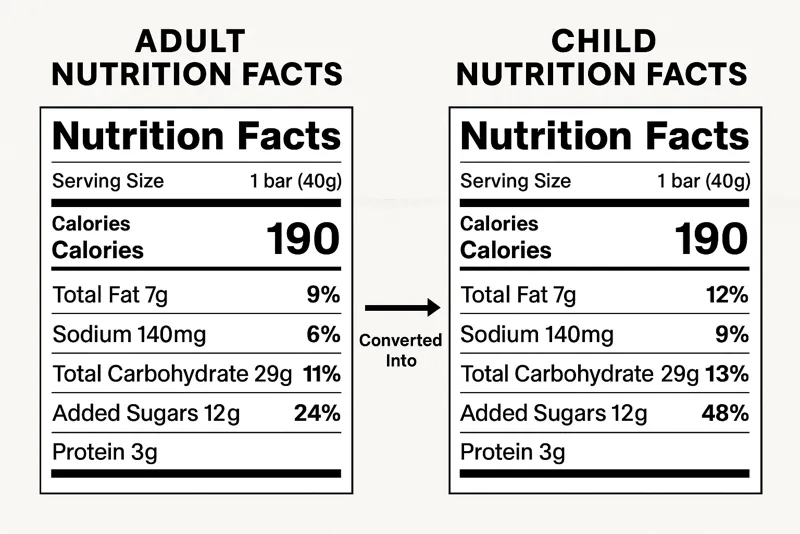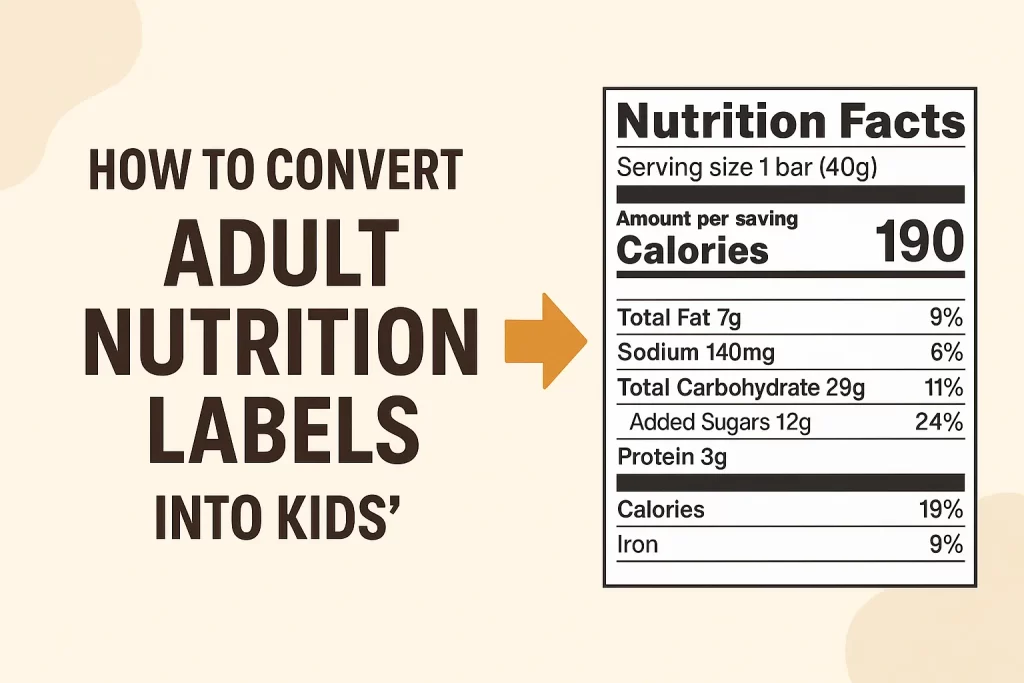When reading food labels, most parents quickly realize they’re designed for adults — not kids. This guide helps you convert adult nutrition labels into kid-appropriate information so you can confidently choose the right foods for your child’s age and needs.

❓ Why Adult Labels Don’t Work for Kids
Adult nutrition labels are based on a 2,000-calorie daily diet. However, children’s calorie and nutrient requirements vary significantly depending on their age, activity level, and gender.
| Age Group | Average Daily Calories |
|---|---|
| 1–3 years | 1,000–1,300 |
| 4–8 years | 1,200–1,600 |
| 9–13 years | 1,600–2,200 |
So if you’re feeding a 5-year-old, that nutrition label geared toward adults needs to be viewed through a different lens.
🔢 Step-by-Step: Adjusting Labels for Children
1. Adjust the % Daily Values (%DV)
Nutrition labels show %DV based on adult needs. For children, scale them down:
| Age Group | Estimate of Adult %DV |
|---|---|
| 1–3 years | 50–60% |
| 4–8 years | 60–75% |
| 9–13 years | 75–100% |
Example: If a food has 20% DV calcium for adults, it provides roughly 12–15% for a 4–8-year-old.
2. Focus on Key Nutrients
Children need certain nutrients more than others. Use the table below for age-specific daily targets:
| Nutrient | 1–3 yrs | 4–8 yrs | 9–13 yrs |
|---|---|---|---|
| Calcium | 700mg | 1,000mg | 1,300mg |
| Iron | 7mg | 10mg | 8mg |
| Vitamin D | 600 IU (all ages) | ||
| Protein | ~13g | ~19g | ~34g |
Compare these against the values listed on the label to assess the nutrient’s contribution.
3. Watch Out for Added Sugars & Sodium
Children are more vulnerable to the negative effects of high sugar and salt intake.
- Added sugars: Limit to under 25g per day for kids 2+
- Sodium: Max of 1,500–1,900mg/day for under-9s
Pro Tip: Use the ingredients list to spot hidden sugars like “glucose syrup,” “evaporated cane juice,” or “fructose.”
🍫 Example: Label Breakdown
Here’s how to interpret a sample granola bar label:
Label Info:
- Calories: 200
- Total Fat: 9g (12% DV)
- Added Sugars: 10g
- Sodium: 150mg
- Calcium: 130mg (10% DV for adults)
For a 6-year-old:
- Calories: Reasonable snack size (200 of 1,400 = ~14%)
- Sugars: 10g = 40% of daily limit – high for a single snack
- Calcium: 130mg = ~13% of their daily goal
💡 Extra Tips for Parents
- ✅ Use meal planning apps with child-specific settings
- ✅ Bookmark child nutrition resources from NHS or AAP
- ✅ Teach kids to read labels so they learn healthy habits early
🔗 5 Smart Eating Habits for Active Kids < Related Reading
📌 Final Thoughts
Decoding adult nutrition labels for kids isn’t just about numbers — it’s about understanding context. By adjusting values and focusing on your child’s unique needs, you can make better food choices that promote long-term health.
🔗 Related Article Suggestion:
Top 10 Healthy Snacks for Kids That Parents Also Love
⚠️ Disclaimer
This article is for informational purposes only and does not constitute medical or nutritional advice. Always consult a pediatrician or registered dietitian for guidance specific to your child’s dietary needs.
Written by the KidsFitnessGear.co.uk Team
Helping parents raise healthy, happy, and active kids — one label at a time.

